Documents: Go to download!
User Manual
- Owner's manual - (English)
- Quick Specs - (English)
- Enery Guide - (English)
- Operating Instructions
- Troubleshooting
Table of contents
Operating Instructions
Control panel
You can locate your model number on the tub wall just inside the door. Throughout this manual, features and appearance may vary from your model.
Models GSD2000, GSD2020 and GSD2030

Models GSD2200, GSD2220 and GSD2230
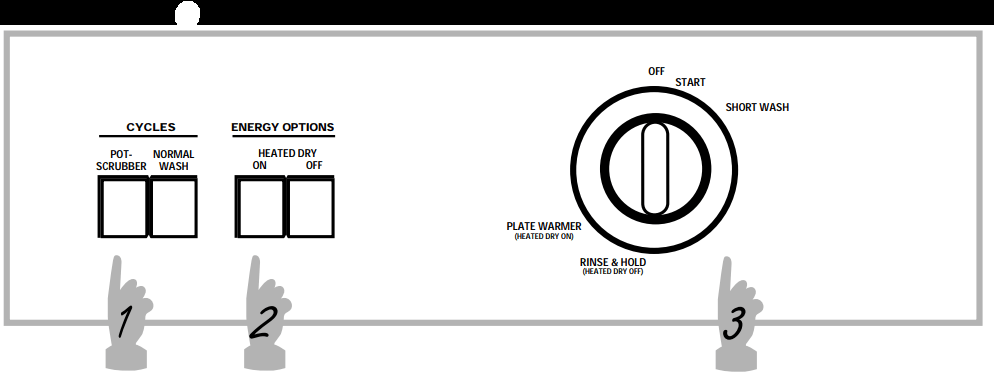
Models GSD3210, GSD3220 and GSD3230
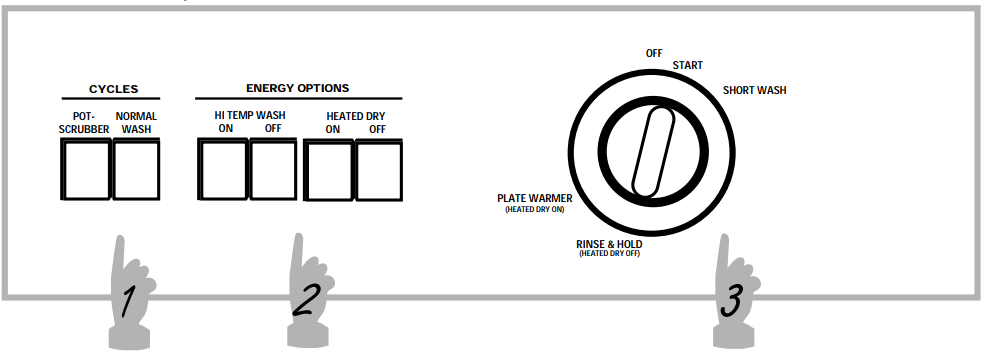
Control Settings
1. Cycles
| POTSCRUBBER/ HEAVY WASH | For heavily soiled dishes or cookware with dried-on or baked-on soils. Everyday dishes may be included. This cycle will not remove burned-on foods |
| NORMAL WASH | For loads of everyday dishes, glasses and cookware with medium soils. NOTE: Many dishes have lighter soil than normal. Choosing a cycle other than NORMAL WASH will save energy and water. |
| SHORT WASH | For quickly washing loads of everyday dishes with medium soils that have not dried on, such as loads consisting mostly of glasses. |
| RINSE & HOLD | For rinsing partial loads that will be washed later. Do not use detergent. |
| PLATE WARMER | For warming clean dishes and serving plates. This cycle will take approximately 31 minutes. |
- Make sure the Dial is at the OFF position.
- Latch the door.
2. Energy Options
| HI TEMP WASH | Provides extra heat for best performance. It is used best with heavily-soiled dishes. |
| HEATED DRY ON | Turns the drying heater on for fast drying. This cycle will extend the time to your wash cycle. |
| HEATED DRY OFF | Shuts off the drying heat options. Dishes air dry naturally and energy is saved. |
3. Start
Slowly turn the Dial to the START position. Don’t turn it past the START position, or you could accidentally miss a rinse. There is a time delay between start-up and water fill so you will not hear any wash action right away
Dial cycles
Short Wash
For quickly washing loads of everyday dishes with medium soils that have not dried on.
- Select the NORMAL WASH cycle and any options.
- Be sure the door is unlatched.
- Slowly turn the Dial to SHORT WASH.
- Latch the door to start the cycle.
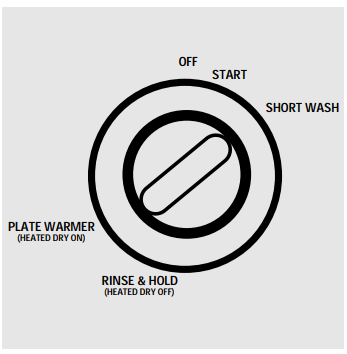
Rinse & Hold
For rinsing partial loads that will be washed later. Do not use detergent.
- Make sure HEATED DRY OFF is selected.
- Be sure the door is unlatched.
- Slowly turn the Dial to RINSE & HOLD.
- Latch the door to start the cycle.
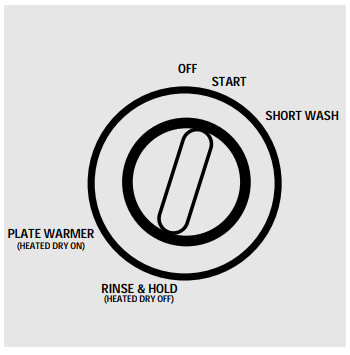
Plate Warmer
For warming clean dishes and serving plates. This cycle will take approximately 31 minutes.
- Load clean dishware to be warmed.
- Select HEATED DRY ON.
- Be sure the door is unlatched.
- Slowly turn the Dial to PLATE WARMER.
- Latch the door to start the cycle.
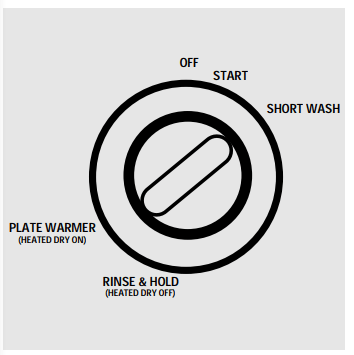
Heavy, Normal and Short Wash (GSD2000, GSD2020 and GSD2030 only)
- Be sure the door is unlatched.
- Slowly turn the dial to the cycle you want.
- Don’t turn it past this position, or you could accidentally miss a rinse.
- Select any options.
- Latch the door to start the cycle.
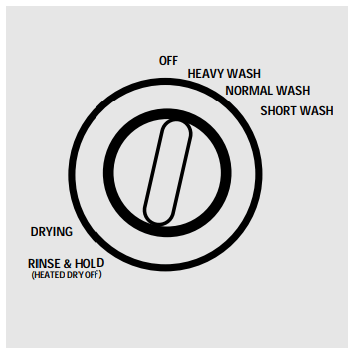
Cycle Sequence

Drying Options:
HEATED DRY ON. Available on all wash cycles except
RINSE & HOLD. Add approximately 31 minutes to the cycle.
HEATED DRY OFF. Drying heater is turned off. Dishes dry naturally.
Using the dishwasher
Check the Water Temperature
The entering water must be at least 120°F. and not more than 150°F., for effective cleaning and to prevent dish damage. Check the water temperature with a candy or meat thermometer. Turn on the hot water faucet nearest the dishwasher, place the thermometer in a glass and let the water run continuously into the glass until the temperature stops rising.
Using a Rinse Agent
A rinse agent, such as JET-DRY, makes water flow off the dishes quickly thereby reducing water spotting.
Fill the rinse agent dispenser until it reaches the bottom of lip inside the opening. Replace cap.
To check if rinse agent is needed, remove the cap and look into the dispenser.
A full dispenser should last about one month.
If rinse agent spills, wipe it up immediately. It can keep your detergent from working.
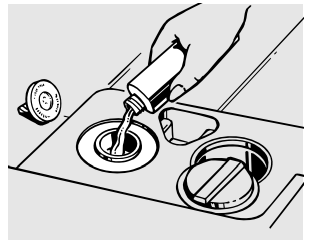
Proper Use of Detergent
Use only detergent specifically made for use in dishwashers. Keep your detergent fresh and dry. Don’t put powder detergent into the dispenser until you’re ready to wash dishes.
The amount of detergent to use depends on whether your water is hard or soft. With hard water, you need extra detergent. With soft water, you need less detergent.
Protect your dishes and dishwasher by contacting your water department and asking how hard your water is. Twelve or more grains is extremely hard water. A water softener is recommended. Without it, lime can build up in the water valve, which could stick while open and cause flooding. Too much detergent with soft water can cause a permanent cloudiness of glassware, called etching.
You’ll find two detergent dispensers on the inside door of your dishwasher. All wash cycles require detergent in the main cup. Wash cycles with two washes will also use the open cup.
Be sure the Dial is at OFF position before adding detergent. Otherwise, the detergent cup will not close and latch properly. Add detergent then close the main cup.
NOTE: To open detergent cup after it has been closed, simply turn the detergent cup handle counter-clockwise until it releases. A snapping sound may be heard.

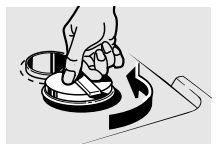
Forget to Add a Dish?
A forgotten dish can be added any time before the main wash.
- Push the door latch to the left.
- Do not open the door until the water spray action stops. Steam may rise out of the dishwasher.
- Add forgotten dishes.
- Close the door and push the latch to the far right.
Loading the dishwasher racks.
For best dishwashing results, follow these loading guidelines. Features and appearance of racks and silverware baskets may vary from your model.
Upper Rack
The upper rack is for glasses, cups and saucers. Cups and glasses fit best along the sides. This is also a secure place for dishwasher-safe plastics. The upper rack is good for all kinds of oddshaped utensils. Saucepans, mixing bowls and other items should be placed face down.
Secure larger dishwasher-safe plastics over two fingers when possible.
Make sure small plastic items are secure so they can’t fall onto the heating element.

The Wash Tower
Keep the center area clear in the lower rack.
The wash tower rises through the center of the lower rack during the wash and rinse portions of the cycle.
Don’t block it or load tall things next to it. A
Also, be careful not to let a portion of an item such as a pot or dish handle extend through the bottom rack. This could block the wash arm and cause poor washing results.
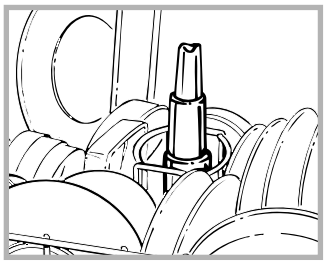
Lower Rack
When loading the lower rack, do not load large platters or trays in the front right corner. They may prevent detergent from circulating during the wash cycle.
The lower rack is best used for plates, saucers, and cookware. Large items such as broiler pans and racks should go along the sides. Load platters, pots and bowls along the sides, in corners, or in the back. The soiled side of items should face the center of the rack.

Silverware Basket
Put flatware in the removable basket with fork and knife handles up to protect your hands. Place spoons in the basket with handles down. Mix knives, forks and spoons so they don’t nest together. Distribute evenly. Small plastic items, such as measuring spoons and lids from small containers, should go in the bottom of the silverware basket with silverware on top.
Don’t let any item extend through bottom.
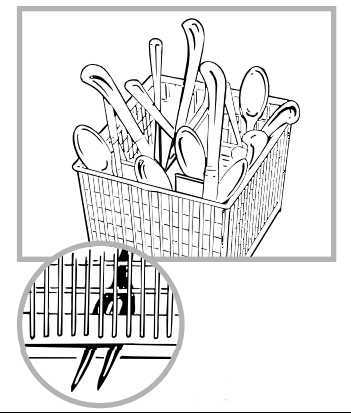
Care and Cleaning
To clean the control panel use a lightly dampened cloth then dry thoroughly. To clean the exterior use a good appliance polish wax.
Never use sharp objects, scouring pads or harsh cleaners on any part of the dishwasher.
Protect Against Freezing
If your dishwasher is left in an unheated place during the winter, ask a service technician to:
- Cut off electrical power to the dishwasher. Remove fuses or trip circuit breaker.
- Turn off the water supply and disconnect the water inlet line from the water valve.
- Drain water from the inlet line and water valve. (Use a pan to catch the water.)
- Reconnect the water inlet line to the water valve.
- Remove the plastic sump cover in the tub bottom and use a sponge to soak up water in the rubber boot.

Does Your Dishwasher Have an Air Gap?
An air gap protects your dishwasher against water backing up into it if a drain clogs. The air gap is not a part of the dishwasher. It is not covered by your warranty. Not all plumbing codes require air gaps, so you may not have one.
The air gap is easy to clean.
- Turn off the dishwasher and lift off the chrome cover.
- Unscrew the plastic cap and clean with a toothpick.
Check the air gap any time your dishwasher isn’t draining well.

Troubleshooting
| Problem | Possible Causes | What To Do |
| Dishwasher won’t run | use is blown, or the circuit breaker tripped | Replace fuse or reset circuit breaker. Remove any other appliances from the circuit. |
| Noise | Some of the sounds you’ll hear are normal | Soft food disposal shredding action. Drain valve opening to pump water out. Timer control as cycle progresses. Detergent cup opening. The motor stopping during the drying period. |
| Utensils are not secure in the rack or something small has dropped into the rack | Make sure everything is secured in dishwasher. | |
| Motor hums | Dishwasher has not been used on a regular basis. If you do not use your dishwasher often, set it to fill and pump out once every week. This will help keep the seal moist and the garbage disposer clear. | |
| Water standing in the bottom of the tub | This is normal | A small amount of clean water around the outlet on the tub bottom at the back of the tub keeps the water seal lubricated. |
| Water won’t pump out of the tub | Drain is clogged | If you have an air gap, clean it. Check to see if your kitchen sink is draining well. If not, you may need a plumber. If the dishwasher drains into a disposer, run disposer clear. |
| Suds in the tub | Correct detergent wasn't used | Use only automatic dishwasher detergents to avoid sudsing. To remove suds from the tub, open the dishwasher and let suds evaporate. Add 1 gallon of cold water to the tub. Close and latch the dishwasher. Pump out water by slowly turning the Dial until a drain period is reached. Repeat if necessary. |
| Rinse agent was spilled | Always wipe up rinse agent spills immediately. | |
| Stained tub interior | Detergent with colorant was used | Some detergents contain colorant (pigment or dyes) that will discolor the tub interior with extended use. Check the detergent cup for signs of any discoloration. If cup is discolored, change to detergent without any colorant. |
| Dishes won't dry | Low inlet water temperature | Make sure inlet water temperature is correct |
| Rinse agent dispenser is empty | Check the rinse agent dispenser | |
| Dishes and flatware not clean | Inlet water temperature is below 120°F. | Raise the water heater not clean temperature to 120°F. |
| Water pressure is temporarily low | Turn on a faucet. Is water coming out more slowly than usual? If so, wait until pressure is normal before using your dishwasher. | |
| Air gap is clogged | Clean the air gap. | |
| Improper rack loading | Make sure large dishware does not block the detergent dispenser or the wash arm. | |
| Spots and filming on glasses and flatware | Extremely hard water | To remove stubborn spots from glassware:
|
| Cloudiness on and glassware | Combination of soft water and too much detergent | This is called etching and is permanent. To prevent this from happening, use less detergent if you have soft water. Wash glassware in the shortest cycle that will get them clean. |
| Water temperature entering the dishwasher exceeds 150°F. | • Lower the water heater temperature. . | |
| Yellow or brown film on tub | Tea or coffee stains | Remove the stain by hand using a solution of 1/2 cup bleach and 3 cups warm water. WARNING Before cleaning interior, wait at least 20 minutes after a cycle for the heating element to cool down. Failure to do so can result in burns. |
| An overall yellow or brown film can be caused way by iron deposits in water | A special filter in the water supply line is the only way to correct this problem. Contact a water softener company. | |
| White film on inside surfaces | Hard water minerals | To clean the interior, apply surfaces dishwasher detergent to a damp sponge. Wear rubber gloves. Do not use any type of cleanser other than dishwasher detergent because it may cause foaming or sudsing. |
| Detergent cup lid won't latch | Dial is not in the OFF position | Turn the Dial to OFF and sllide the door latch to anh left. |
| Detergent cup in dispender cups | Dishes are blocking the dedergent cups | Reposition the dishes. |
| Steam | This is normal | Steam come through the vent by the door latch during drying and when water is being pumped out. |
| Blach or gay marks on sishes | Aluminum utensils have rubbed against dishes | Remove marks with a mild, abrasive cleaner. |
See other models: RGB746HED3CT JSP42DN2BB GTS15BCMDRCC GSS20IETJBB JB700DN1WW
